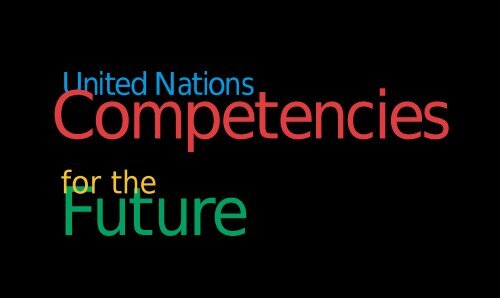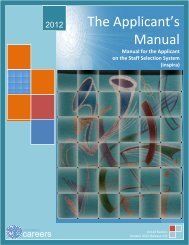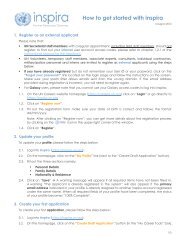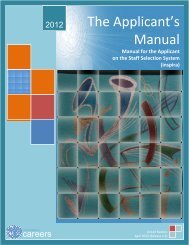Competencies - UNEP
Competencies - UNEP
Competencies - UNEP
- No tags were found...
You also want an ePaper? Increase the reach of your titles
YUMPU automatically turns print PDFs into web optimized ePapers that Google loves.
“ It is my hope that competencies will provideus with shared language for talking, in concreteterms, about high performance and managerialexcellence. I believe that a shared view ofthe standards we are striving to achieve willassist us in our continuing efforts to preparethe Organization to meet the challenges ofthe 21st century.”Kofi AnnanSecretary-General
Introduction to <strong>Competencies</strong>In “Building the Future”, the Secretary-General has indicated thatthe Organization’s greatest strength—and the key to our success—isthe quality of our staff and managers. He has stressed that, to capitalizeon this strength, we need to create an organizational culture andenvironment that enables staff to contribute to their maximum potential.Experience in other organizations has shown that when seeking to createa new culture and build human resources capacity for the future, it isimportant to define organizational core competencies—the combinationof skills, attributes and behaviours which are essential for all staff—as wellas the additional managerial competencies required by all those whomanage others. Once organizational competencies have been defined,they can be used as a base on which to build and strengthen other humanresources systems such as recruitment, placement, development andperformance appraisal.
Accordingly, a participatory process, involving staff and managersthroughout the Secretariat, was undertaken to define core and managerialcompetencies for the United Nations Secretariat. This booklet hasbeen prepared to inform staff of the United Nations competencies forthe future, to describe how these competencies were arrived at, toprovide examples of how the competencies look in action and to indicatehow they will be applied in the Secretariat.
What are competencies?The term “competency” refers to a combination of skills, attributes andbehaviours that are directly related to successful performance on the job.Core competencies are the skills, attributes and behaviours which areconsidered important for all staff of the Organization, regardless of theirfunction or level.Managerial competencies are the skills, attributes and behaviourswhich are considered essential for staff with managerial or supervisoryresponsibilities.
Core and managerial competencies are not specific to any occupation. Onecould demonstrate the competency of “teamwork” or “client orientation”,for example, in performing any job. Specific technical competencies arenot included in the model of United Nations competencies for the future.To complement the core competencies, individual departments may chooseto define functional competencies related to their respective areas of work.Why are competencies important ?Defining competencies is important both for the Organization and for staff.<strong>Competencies</strong> are forward-looking. They describe the skills and attributes staffand managers will need in order to build a new organizational culture andmeet future challenges. They help organizations clarify expectations, definefuture development needs, and do more focused recruitment and developmentplanning. <strong>Competencies</strong> provide a sound basis for consistent and objectiveperformance standards by creating shared language about what is neededand expected in an Organization.
How were the United Nationscompetencies decided?Core and managerial competencies for the United Nations Secretariathave been developed through a participatory process taking intoaccount the diversity of levels, functions, cultures and geographiclocations of the Organization.IInterviewsAs part of the process, interviews were conducted with the Deputy Secretary-Generaland twenty-four Under-Secretaries-General and Assistant Secretaries-General whohead Departments and Offices throughout the Secretariat. They were asked about theOrganization's environment, stakeholders, work outputs and future challenges. Informationdrawn from the interviews provided an overall context for the work of focus groups.
Focus GroupsSeventeen focus groups, comprising a cross section of staff from different departmentsat all levels, were held in six duty stations. The focus groups participated in a day-longprocess of examining the Organization's environment, the work we do and expectto do in the future, and the needs of our clients and stakeholders. Each group cameto a consensus on the most important competencies and values for all international civilservants, as well as the additional competencies required by staff who manage others.Building the Competency ModelThe competencies defined by all groups were sorted and analysed. Similar competencieswere grouped together and a common term chosen for each grouping. Using the mostfrequently occurring items, a model was developed with eight core competencies andsix managerial competencies.Organizational Core ValuesOrganizational values are the shared principles and beliefs that underpin the work ofan organization and guide the actions and behaviours of its staff. During the participatoryprocess, “integrity”, “respect for diversity” and “professionalism” emerged asthe Organization’s core values, and they have been included in the model. They areconsonant with the United Nations Charter and with the core values set out in Article Iof the Staff Regulations.
How will thecompetencies be used?Staff DevelopmentStaff development programmes will be aligned with the competencies and newprogrammes introduced to support their development. A guide will be preparedexplaining the various means available to acquire and strengthen competencies.Career Planning<strong>Competencies</strong> will increasingly be used as a basis for identifying individual andorganizational needs and planning for development. Support will be providedto staff through publications and career support workshops.Performance Management<strong>Competencies</strong> will be useful to staff and managers in assessing developmentneeds and setting performance standards. <strong>Competencies</strong> will be incorporatedin subsequent revision of the PAS.
RecruitmentGradually, competencies will be incorporated into generic job descriptions andvacancy announcements. Interview frameworks and other tools will be developedto incorporate competencies into recruitment and placement decisions, andstaff will be trained in the use of these tools.How do Iacquire the competencies?<strong>Competencies</strong> include a combination of skills, attributes and behaviours that needto be developed and strengthened throughout one's career. Acquiring a competencyis not a one-time event, but rather an ongoing process. Formal training can help,but experience, coaching, feedback and individual learning activities are needed aswell. To assist staff in using competencies in their daily work and planning for theircontinuous learning and development, ongoing information and guidance will beprovided by OHRM.
What are theUN core values andcompetencies?Core Values■ Integrity■ Professionalism■ Respect for Diversity
Core <strong>Competencies</strong>■ Communication ■ Teamwork■ Planning & Organizing■ Accountability ■ Creativity ■ Client Orientation■ Commitment to Continuous Learning■ Technological AwarenessManagerial <strong>Competencies</strong>■ Leadership ■ Vision ■ Empowering Others■ Building Trust ■ Managing Performance■ Judgement/Decision-making
What docompetencies look likein practice?As competencies relate more to what a persondoes, than what a person knows, they are observable.For each competency it is possible to describe“behavioural indicators” – actions or behaviours thatexemplify the competency in practice. These maybe helpful in promoting shared values and commonstandards of performance and behaviour throughoutthe Organization.
The following pages set out the organizational corevalues, core competencies and managerial competencies,followed by “behavioural indicators”. These indicatorsare indicative only. They are not intended to describeall the behaviours related to a competency.
Integrity▼
■■■■■■Demonstrates the values of the United Nations indaily activities and behavioursActs without consideration of personal gainResists undue political pressure in decision-makingDoes not abuse power or authorityStands by decisions that are in the Organization’s interest,even if they are unpopularTakes prompt action in cases of unprofessional orunethical behaviour
Professionalism▼
■■■■■■Shows pride in work and in achievementsDemonstrates professional competence andmastery of subject matterIs conscientious and efficient in meeting commitments,observing deadlines and achieving resultsIs motivated by professional ratherthan personal concernsShows persistence when faced with difficultproblems or challengesRemains calm in stressful situations
Respect forDiversity▼
■■■■■■Works effectively with people from all backgroundsTreats all people with dignity and respectTreats men and women equallyShows respect for and understanding of diversepoints of view and demonstrates this understandingin daily work and decision-makingExamines own biases and behaviours to avoidstereotypical responsesDoes not discriminate against anyindividual or group
Communication▼
■■■■■Speaks and writes clearly and effectivelyListens to others, correctly interprets messagesfrom others and responds appropriatelyAsks questions to clarify, and exhibits interest inhaving two-way communicationTailors language, tone, style and formatto match the audienceDemonstrates openness in sharing informationand keeping people informed
Teamwork▼
■■■■■Works collaboratively with colleagues toachieve organizational goalsSolicits input by genuinely valuing others’ ideas andexpertise; is willing to learn from othersPlaces team agenda before personal agendaSupports and acts in accordance with finalgroup decision, even when such decisions maynot entirely reflect own positionShares credit for team accomplishments and acceptsjoint responsibility for team shortcomings
Planning &Organizing▼
■■■■■■Develops clear goals that are consistentwith agreed strategiesIdentifies priority activities and assignments;adjusts priorities as requiredAllocates appropriate amount of time and resourcesfor completing workForesees risks and allows for contingencieswhen planningMonitors and adjusts plans and actions as necessaryUses time efficiently
Accountability▼
■■■■■Takes ownership of all responsibilities andhonours commitmentsDelivers outputs for which one has responsibility withinprescribed time, cost and quality standardsOperates in compliance with organizationalregulations and rulesSupports subordinates, provides oversight and takesresponsibility for delegated assignmentsTakes personal responsibility for his/her own shortcomingsand those of the work unit, where applicable.
ClientOrientation▼
■■■■■■Considers all those to whom services are provided tobe “clients ” and seeks to see things from clients’ point of viewEstablishes and maintains productive partnerships withclients by gaining their trust and respectIdentifies clients’ needs and matches them toappropriate solutionsMonitors ongoing developments inside and outside theclients’ environment to keep informed and anticipate problemsKeeps clients informed of progress or setbacks in projectsMeets timeline for delivery of products or services to client
Creativity▼
■■■■■■Actively seeks to improve programmes or servicesOffers new and different options to solve problemsor meet client needsPromotes and persuades others to consider new ideasTakes calculated risks on new and unusual ideas;thinks "outside the box"Takes an interest in new ideas andnew ways of doing thingsIs not bound by current thinking ortraditional approaches
TechnologicalAwareness▼
■■■■Keeps abreast of available technologyUnderstands applicability and limitations of technologyto the work of the officeActively seeks to apply technology to appropriate tasksShows willingness to learn new technology
▼Commitmentto ContinuousLearning
■■■■■Keeps abreast of new developmentsin own occupation/professionActively seeks to develop oneself professionallyand personallyContributes to the learning of colleaguesand subordinatesShows willingness to learn from othersSeeks feedback to learn and improve
Vision▼
■■■■Identifies strategic issues, opportunities and risks.Clearly communicates links between theOrganization’s strategy and the work unit’s goals.Generates and communicates broad and compellingorganizational direction, inspiring others to pursuethat same directionConveys enthusiasm about future possibilities
Leadership▼
■■■■■■■Serves as a role model that other people want to followEmpowers others to translate vision into resultsIs proactive in developing strategies to accomplish objectivesEstablishes and maintains relationships with a broadrange of people to understand needs and gain supportAnticipates and resolves conflicts by pursuingmutually agreeable solutionsDrives for change and improvement; does notaccept the status quoShows the courage to take unpopular stands
EmpoweringOthers▼
■■■■■■Delegates responsibility, clarifies expectations, and givesstaff autonomy in important areas of their workEncourages others to set challenging goalsHolds others accountable for achieving results relatedto their area of responsibilityGenuinely values all staff members' input and expertiseShows appreciation and rewards achievement and effortInvolves others when making decisions that affect them
▼ManagingPerformance
■■■■■■■■Delegates the appropriate responsibility, accountabilityand decision-making authorityMakes sure that roles, responsibilities and reporting linesare clear to each staff memberAccurately judges the amount of time and resources neededto accomplish a task and matches task to skillsMonitors progress against milestones and deadlinesRegularly discusses performance and provides feedbackand coaching to staffEncourages risk-taking and supports creativityand initiativeActively supports the development and careeraspirations of staffAppraises performance fairly
Building Trust▼
■■■■■■■Provides an environment in which others can talk andact without fear of repercussionManages in a deliberate and predictable wayOperates with transparency; has no hidden agendaPlaces confidence in colleagues, staff members and clientsGives proper credit to othersFollows through on agreed upon actionsTreats sensitive or confidential information appropriately
▼Judgement/Decision-making
■■■■■■■■Identifies the key issues in a complex situation, and comes tothe heart of the problem quicklyGathers relevant information before making a decisionConsiders positive and negative impacts of decisionsprior to making themTakes decisions with an eye to the impact on othersand on the OrganizationProposes a course of action or makes a recommendationbased on all available informationChecks assumptions against factsDetermines that the actions proposed will satisfy the expressedand underlying needs for the decisionMakes tough decisions when necessary
What’sNext?▼
Integrating competencies into the Organizationis an ongoing process. As a first step, pleaseuse this booklet to familiarise yourself with theorganizational values and competencies. Useand observe the competencies in your dailywork and in discussing staff development andperformance management issues. The bookletwill be supplemented by additional publicationsto assist staff and managers in usingand strengthening competencies to enhanceperformance, increase accountability at alllevels, and promote continuous development.Specialist Services Division, OHRM
99-93325—November—18M






